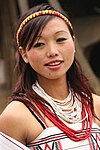Tangsa Naga
This list is not complete: Notes: Gakat people also live in India, in the Wakka village circle of Tirap district, but are grouped with the Wancho rather than with Tangsa.Tangsa men traditionally used to wear a long and narrow piece of cloth called lamsam/lengti that covers the hip and pelvis region.However, nowadays they wear a broad cylindrical piece of cloth called lungi that is green in colour and is lined with yellow, red and white yarns, and accompanied with a sleeveless shirt.Nowadays, with the availability of yarn, their costume include an artistically woven petticoat, which acts as the lower garment, and a linen blouse.In the traditional agriculture, using simple manual tools, the Tangsa raise crops that include paddy, millet, maize and arum, and vegetables.Traditional drinks include smoked tea (phalap) and rice beer (called ju, kham or che).A tribal council, known as Khaphua (Longchang), Khaphong (Muklom) was administered by a Lungwang (chief), who sees to the daily affairs of the Tangsa group.One example of the animistic beliefs still practised is the Wihu Kuh festival held in some parts of Assam on 5 January each year.The Mossang, Rongrang, Morang, Yougli, Sanke, Longphi, Haisa, and Chamchang (Kimsing) ethnic groups are mostly Christian.The closest linguistic relatives to Tangsa are Tutsa and Nocte, and all of these, together with several other languages, make up the Konyak subgroup within a larger group sometimes called Bodo-Konyak-Jinghpaw.They are people who came from Myanmar to India some hundreds of years ago and there are no Tikhak or Yongkuk speakers in Indi these days.Hakhun is very similar to Nocte, which is listed by the ISO as a different language (ISO639-3:njb) An alphabetic writing system was invented for Tangsa in 1990 by Lakhum Mossang (d. 11 July 2020).
Naga woman
wax figuresJawaharlal Nehru Museum, ItanagarArunachal PradeshMyanmarSagaing RegionKachin StateTangsa languageChristianityAnimismRangfrahHinduismKonyakTibeto-BurmeseTangsaIndian ConstitutionLongchangLungriMuklomPonthaiTikhakshifting cultivationTheravada Buddhismethnic groupsTangsa (Unicode block)ISO 15924UnicodeUnicode rangealphabeticThe TelegraphUnicode ConsortiumAngamiChakhesangChotheKharamKhiamniunganLainongLamkangLiangmaiMakuryMaringMonsangPochuryPoumaiRengmaRongmeiSangtamTangkhulThangalTikhirWanchoYimkhiungTribes of Arunachal PradeshMishmiAka (Hruso)Apa TaniDigaro MishmiGalo/GallongHill MiriKhambaKhamtiKhamyangBugun (Khowa)Mikir (Karbi)MinyongMiju Mishmi (Kaman)MishingNyishiSherdukpenSingphoSulungZekhringChugpaLishipaHill tribes of Northeast IndiaMizoramChakmaDimasa (Kachari)HajongKhasi and JaintiaSynteng or PnarLyngngamKuki TribesMan (Tai speaking)Mizo (Lushai) tribesNaga tribesPawi (Lai)Synteng (Pnar)YimkhiungNagaNagalandBodo-KachariMeghalayaKhasi Synteng or PnarLakher (Mara)Abor (Galo)ApataniDafla (Nyishi)GalongKhowa (Bugun)Miju MishmiSingpho (Jingpo)Tai peoplesKhamptiMishing (Miri)PuroikManipurGangteKoirao (Thangal)KoirengSuhte (Paite)ThadouVaipheiTripuraBhutiaJamatiaKhasiaLepchaLushai (Mizo)Munda, KaurNoatiaSantalTripuriSikkimSherpaTibetanHrangkhwal, RangkholKhelma